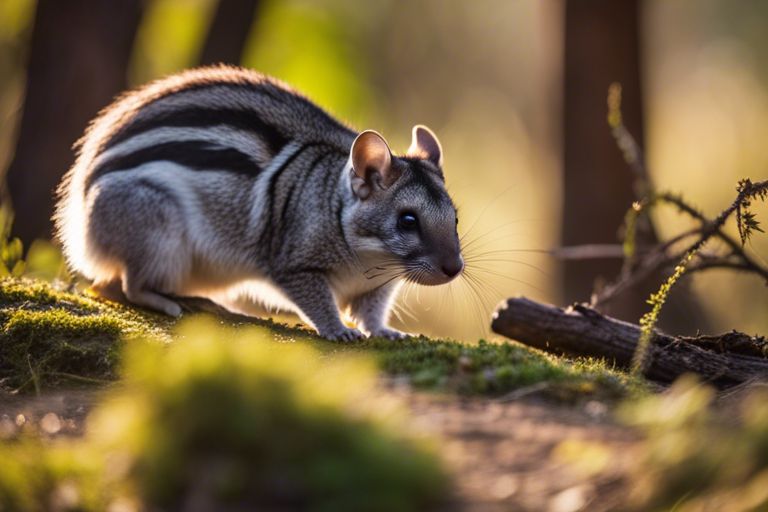Chinchillas, native to the Andes mountains, face numerous challenges in their natural habitats, including predation by various animals. These small, nocturnal mammals have evolved numerous strategies to evade predators, yet their survival remains precarious due to both natural and human-induced threats. Below, we outline the specific predators chinchillas face and the adaptations they use to survive.
Key Takeaways:
- Primary Predators: Birds of prey such as hawks and eagles pose significant threats to chinchillas in the wild.
- Mammalian Hunters: Foxes, weasels, and even domestic cats are common predators of chinchillas.
- Human Activities: Habitat destruction and hunting exacerbate the risks for wild chinchilla populations.
- Survival Tactics: Chinchillas rely on their agility, dense fur, and nocturnal habits to evade threats.

Natural Predators
Chinchillas in the wild face predation from a variety of avian and mammalian hunters, each adapted to target small animals like chinchillas. Protecting chinchillas in captivity requires understanding these natural threats.
Birds of Prey
Birds of prey, including eagles, hawks, and owls, are among the most dangerous predators to chinchillas. These raptors use their sharp talons, excellent vision, and aerial agility to hunt chinchillas. Attacking from above, they can easily spot chinchillas despite their rocky habitats.
Mammalian Predators
Several mammals also hunt chinchillas, using stealth and speed to ambush them. Key examples include:
- Foxes: Use their keen senses and cunning behavior to stalk chinchillas.
- Weasels: Agile and relentless, they target small prey like chinchillas in their burrows.
- Domestic Cats and Dogs: These pets can become predators if chinchillas escape their enclosures.
- Ferrets and Coyotes: Stealthy and opportunistic, they pose significant risks to wild chinchillas.
Ensuring chinchillas have secure habitats, both in the wild and captivity, is critical to minimizing these threats.
Human Impact
While natural predators pose a serious threat, human activities have become the largest challenge to chinchilla populations. Habitat destruction and hunting continue to endanger these animals at an alarming rate.
Habitat Destruction
Urbanization, agriculture, and mining fragment or completely eliminate the natural rocky habitats where chinchillas thrive. This forces them into smaller, less protected areas, making them more vulnerable to predators and reducing their chances of survival.
Hunting and Pet Trade
Chinchillas have been heavily hunted for their luxurious fur, leading to drastic population declines. Despite legal protections in some regions, poaching and illegal trading persist, driven by demand for their pelts and the exotic pet market.
Survival Adaptations
Chinchillas have developed remarkable adaptations to avoid predators and survive in their harsh environments.
Physical Defenses
- Dense Fur: Acts as camouflage in rocky terrains and provides protection from bites.
- Small Size and Agility: Allows them to navigate crevices where predators cannot reach.
Behavioral Strategies
Chinchillas employ several survival behaviors to evade predators:
- Nocturnal Activity: They are most active at dawn and dusk, avoiding predators hunting in broad daylight.
- Quick Escapes: Using agility, chinchillas can leap across rocky terrain and hide in crevices.
- Freezing in Place: When threatened, they often freeze to avoid detection by predators relying on movement.
- Social Alerts: Living in groups, they use vocalizations and behaviors to warn each other of danger.
Threats and Defenses of Chinchillas
| Threat | Examples | Defense Mechanism |
|---|---|---|
| Birds of Prey | Hawks, Eagles, Owls | Dense fur, agility, rocky terrain |
| Mammalian Predators | Foxes, Weasels, Domestic Cats | Burrows, quick movement, freezing |
| Human Impact | Habitat destruction, poaching | Conservation areas, legal protection |
Conservation Efforts
Protecting chinchillas involves addressing both their natural predators and human impacts. Conservation initiatives focus on habitat preservation, captive breeding, and public awareness.
Protected Areas
Establishing protected habitats has been a critical step in safeguarding chinchillas. These areas shield chinchillas from human interference and provide safe zones where they can thrive.
Breeding Programs
Breeding programs in zoos and wildlife centers ensure genetic diversity and help bolster populations. These programs simulate natural habitats to maintain chinchillas’ survival instincts while offering education about their plight.
Summary
Chinchillas face a range of predators in their natural environments, including birds of prey and small mammals. Human activities like habitat destruction and hunting have only added to their challenges. To protect chinchillas, it is essential to understand their predators and support conservation efforts that preserve their habitats and raise awareness about their survival needs.
FAQ
Q: What are the main predators of chinchillas?
A: Chinchillas face threats from birds of prey, including hawks, eagles, and owls, as well as mammals like foxes, weasels, and domestic cats or dogs.
Q: How do chinchillas avoid predators?
A: Chinchillas rely on agility, dense fur for camouflage, and nocturnal habits to evade predators. They also hide in rocky crevices and warn each other of danger using vocal signals.
Q: What measures protect chinchillas from predators in captivity?
A: Secure cages with lockable doors, solid flooring, and proper ventilation help protect chinchillas. Avoid outdoor exposure unless fully secured and free of potential threats.
Q: Are human activities a bigger threat to chinchillas than predators?
A: Yes, habitat destruction, hunting, and the pet trade pose greater risks to chinchillas than natural predators. Conservation efforts are essential to their survival.
Q: How can I help chinchilla conservation efforts?
A: Support organizations that protect chinchilla habitats, participate in educational programs, and avoid purchasing products or pets from unregulated markets.
